Temporally, an immense amount of time separates a chart detailing categories of castes and mixtures of races produced in the 19th century, and the 2011 immersive installation Return to the Present by Mexican artist Erick Meyenberg. Yet, both chart and installation are intertwined to a history of racial discourse dating back to Colonial times that still prevails in contemporary societies. Meyenberg’s aim to address this issue has Germany as its locus, and Mexico as its historical context. From 2005 to 2010, Meyenberg studied in Germany at the Berlin University of the Arts (Universität der Künste), where he was classified in that category that Homi K. Bhabha has described as “almost the same but not quite.”1 Although in Mexico he had passed for white, in Germany, other factors attached to nationhood differentiated him from them. Interestingly, for Meyenberg, this experience revealed that despite the many obvious existing differences between Germany and Mexico, both countries were bound to a common history of race construction that has continuously repeated itself, suspended in a present continuous, despite its outdated basis. Meyenberg’s installations provide critical insights in the ways in which the past connects to the present. Specifically, his experiences in Germany and Mexico made him reflect on the context of the latter country, where despite the fact that racial mixing has been the rule more than the exception, racism continues to prevail2.
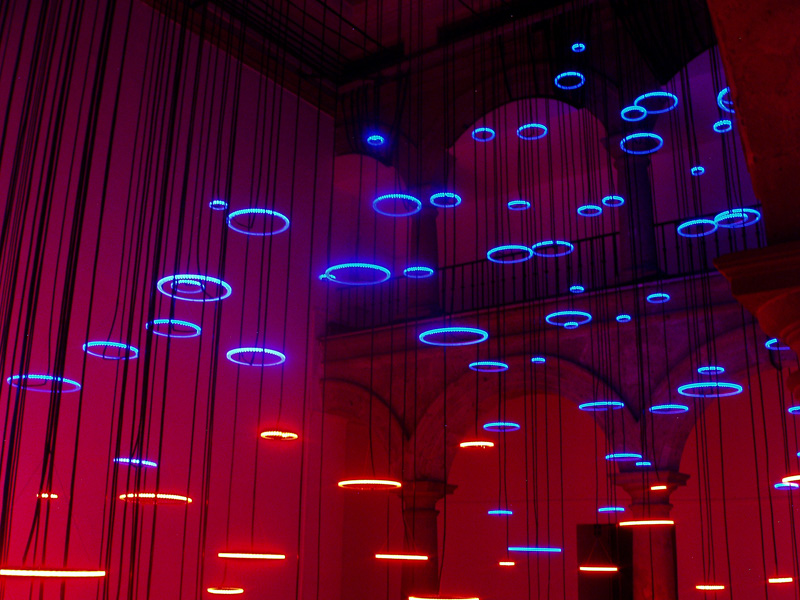
In the past years, Meyenberg’s research has focussed on racial mixtures. A central element of his work is the gradual transformation of color in real time using LEDs (Light Emmitting Diodes) in a literal yet poetic way to explore questions of racial discourse formation and stratification. LEDs’ logic lies in the mixture of red, green and blue (RGB); together, these colors have the capacity to produce a vast array of tones and colors, while the effect of lighting the three of them at the same time, space, and intensity produces white light. Meyenberg uses this technical feature to evoke narratives of racial superiority in relation to whiteness3. In what follows, I discuss the installations Return to the Present and Étude taxonomique et comparative entre les castes de la Nouvelle Espagne et celles du Mexique contemporain. Both works put forth historical connections where gallery visitors are provoked to position themselves, and those around them, within past and present histories of race construction and racism.
The Loop: Race in Time
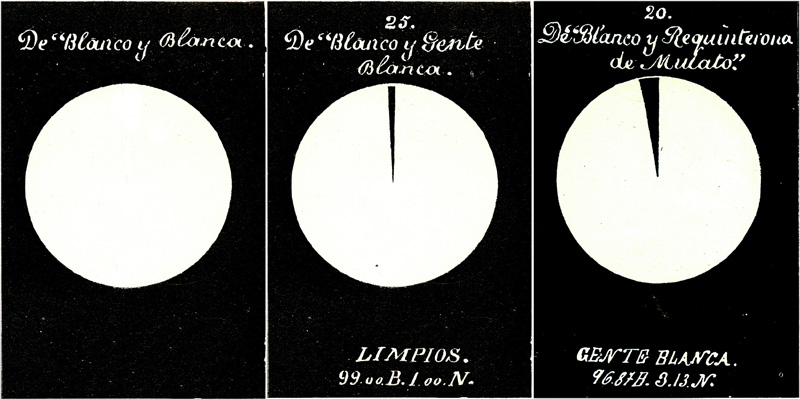
Meyenberg’s Return to the Present was first shown at the Arróniz Contemporary Art Gallery in Mexico City in 2011. The installation consists of an LED band, three meters in diameter, suspended in the center of the exhibition space. As the circular structure is installed about 1.5 meters above the floor, gallery visitors can enter the space and become part of the piece’s transformation. A series of LEDs are programmed to change intensity, each transformation denoting blood percentages representative of different racial categories in New Spain according to a 19th century chart classifying fifty-two kinds of races depending on blood mixture. The diagram traces combinations and labels them according to blood percentages. For example, chart no. 32 represents the mixture of a white male and a black female resulting in a mulato; chart no. 8 represents the mixture of a white male (75 percent white) and a female mestiza (25 percent black) which gives rise to a castizo cuatralvo.

Return to the Present, Erick Meyenberg
In Return to the Present, M. translates these blood mixture categories using LEDS functioning in real time. The LED’s band starts fully lit in white, representing the mixture between a white female and a white male; gradually, the light’s intensity change in a clock-wise direction until the LEDs are turned off and the exhibition space becomes completely dark, representing the race that results from the mixture of a black male and a black female. The allusion to the passing of time is striking at this point, for the transformation of the light and the movement forward evokes conversely a movement backwards, one that suggests a return to Colonial times when racial prejudices were constructed to justify violence, exploitation, and especially the privilege of white bodies and identities over others. Still, as the races are being mixed and the clock moves forward on the LED’s band, its progression is fixed within in a loop that keeps it suspended in the past. This critical tone is further emphasized in the work’s title, suggesting viewers’ direct relationship with that continuous present where their own bodies are caught in the racial vicious circle. In addition, as the cycle begins with white lights and finishes in total dark, the allusions of whiteness to positive features and light, and blackness to negative features and darkness are poetically interrogated.
In both literal and metaphorical ways, Return to the present has a seductive appeal for gallery visitors. To begin, the light emanating from the piece is reflected on their bodies, while further connections can be drawn if they decide to position themselves in relation to the chart displayed beside the work. Viewers’ bodies can thus become part of the racial mix, and if they enter the LED band, the racial labeling spreads inwards at the same time it projects towards the outside, thus evoking the many ways in which identity formation plays a crucial role in social dynamics and conflicts and begins precisely at the level of discourse within the individual. This is key, given that so-called scientific discourses on race have been dismissed since the end of the 19th century, and yet, as scholars such as bell hooks has demonstrated, popular notions of race have not changed.4 A brief review on race construction is thus needed. In their Racial Formation in the United States, Michael Omi and Howrad Winant explain that since the 16th century, the word race “was used with growing frequency in a literal sense denoting simply a class of persons or even things.” In the 19th and 20th centuries, however, “this loose usage began to give way and the word came to signify groups that were distinguished biologically ”5. Science and knowledge were then used to legitimize practices based on racial constructs, thus erecting categories of superiority and inferiority functioning to organize societies at the economic, political, social and cultural levels. In this regard, scholar Lucius Outlaw states that the function of race as a “classificatory device gained new authority” in the 18th century when “evidence from sciences such as geology, zoology and anatomy was assembled to support a claim that racial classification would help explain many social differences”6. These differences, as Outlaw concludes, have justified social inequalities and power structures, although they have been proven wrong by more recent studies. For example, by the end of the 19th century, the work of Darwin and Mendel complicated much of the early constructions of race. Although Darwin’s principles were useful in justifying the dominance of certain groups over others, his Origins, Outlaw explains, “shifted the terrain of scientific discourse from morphology and the stability of ‘pure types’ to a genetic-based approach to individual characteristics, and the effects on them on processes of change, thus to a focus on the analysis of variety (variation within a population and between populations).” Eventually, it became clear that “racial categories are fundamentally social in nature and rest on shifting of biological heterogeneity,” and that in fact, as Outlaw states “race is a social formation”7.
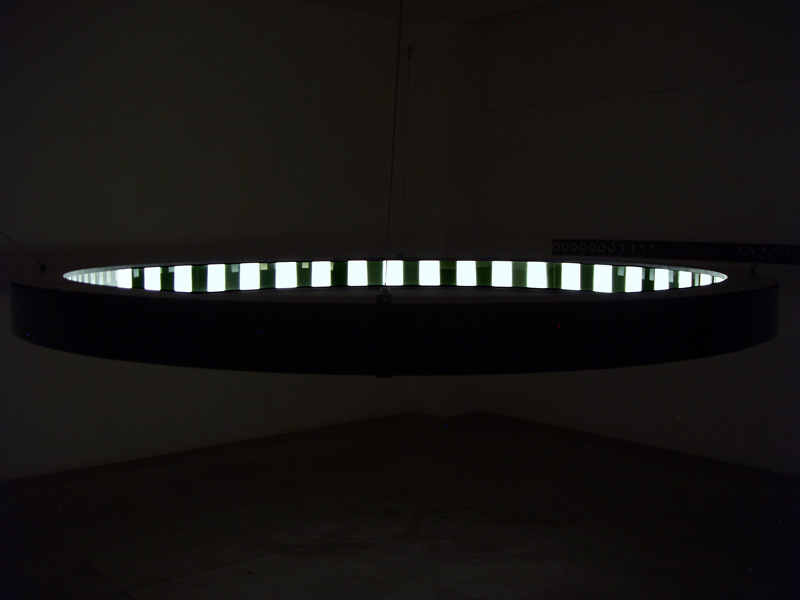
It is precisely for this reason that the relationships between past and present, discourse and experience instigated in Meyenberg’s work are crucial. No matter how false or “scientifically inadequate” the precepts on race are, the lived experience of people still rests on racial prejudices today, as much as it did in colonial times. In fact, if Meyenberg’s Return to the Present reflects on blood percentages representative of the different races in the New Spain, it is because many people in contemporary Mexico are still proud to emphasize their link to white Spanish ancestors, as if an aura of superiority surrounds them depending on their percentage of whiteness. But even if Meyenberg uses Mexico as a case study, the issues he addresses are as “universal » as the constructs in which racial discourses rest upon
Yesterday’s and Today’s Taxonomic Study
Étude taxonomique et comparative entre les castes de la Nouvelle Espagne et celles du Mexique contemporain, Erick Meyenberg
In his 2010 installation Étude taxonomique et comparative entre les castes de la Nouvelle Espagne et celles du Mexique contemporain, Meyenberg continues to draw from classifications of racial mixing. This long title in French alludes to a period where the scientific discoveries of the Old Continent — mostly those produced in French — functioned as a paradigm for post-Revolutionary Mexican scientists. Étude taxonomique was first exhibited in 2010 at the House of World Cultures in Germany, and later that same year at the Laboratorio Arte Alameda in Mexico City for the collective show RevolucionES8. Given the historical context of the exhibit in Mexico, Meyenberg seeks to compare 16th Century racial constructions in the New World with the genetic coding of Mexicans as in 2009. According to the artist, « the goal is to denounce the racist and classist situation that we still live in Mexico. Some scientific concepts such as race, should remain locked in the drawers of history, however, they return again and again, as unresolved historical situations”9.
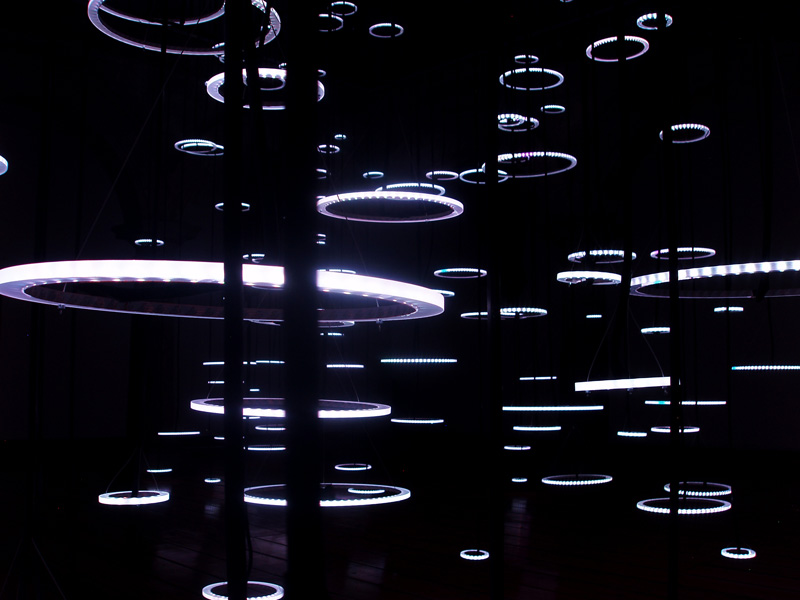
Étude taxonomique, is an immersive sound installation filled with 205 polycarbonate-rings with LEDs suspended in a darkened room. The lights are programmed to gradually transform from RGB colors (red, green, and blue) to lighter tones such as pale pink, light blue, and white, creating a hypnotic space. While the transformation of color connects the RGB model to the three main “races” forming Mexican’s population, the rings’ vertical positions allude to social divisions mainly influenced by class. Additionally, the rings’ organization in 22 columns distributed throughout the gallery relates to 22 individual blood mixtures10. Based on the similarities of blood-percentage that the artist found among 22 individuals on a 19th Century study of racial intermixture produced by a French anthropologist, and 22 individuals on a 2009 study on patterns of genome in Mexicans commissioned by the Mexican Government, Meyenberg created an installation in which the mixing of these individuals unfolds in a three-axis logic: X for native blood, Y for black blood, and Z for white blood. These connections are also supported by the sonic components of the installation: three digitally altered segments of vocal sounds representative of the three different racial groups are synchronized with the racial mixture taking place in the LED’s. Together, sound and light interweave in a gradual transformation evoking racial discourses ordering Mexico’s social, economic and cultural relations. Following this further, an adjoining room displaying books, charts, tables, and other documents from scientific, biological, and artistic discourses provide information that have been central to Meyenberg’s own research process11. At the same time, some of these pieces directly dialogue with the installation. For instance, a 1715 painting by Spanish Baroque painter Juan Rodríguez Juarez, associates the three characters on the painting to the intermixed display of the LED’s rings — a digital print of the painting was intervened by Meyenger with acrylic painting, covering the characters’ faces with colored circles corresponding to their blood percentage of native, black and white.
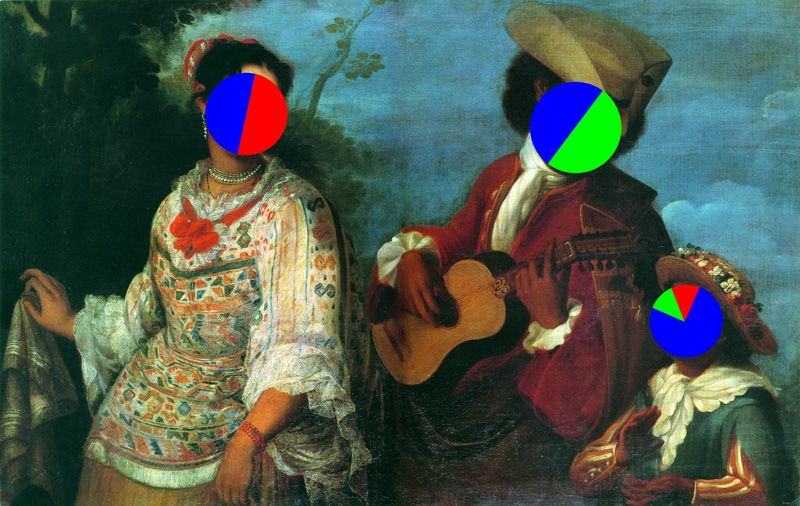
The documents on display allow viewers to connect aesthetic experience to the production of knowledge on race. As the documentation includes the aforementioned research on the patterns of genome in Mexicans, the link between Colonial racial division and contemporary Mexico is left to gallery visitors, who are free to make associations and to reflect on their trust on the racial constructions defining the installation’s organization and Mexico’s social dynamics. In addition, Étude taxonomique alludes to the utopian project proposed by Manuel Gamio — considered the pioneer of anthropology in Mexico. In his 1916 book Forjando patria, Gamio suggested the blending (mestizaje) of biological and cultural elements in order to erase all kinds of differences and to produce a true Mexican identity and race. The emerging race is evoked in the installation with the formation of the white light. In this sense, the installation’s whiteness could be seen to as representing Gamio’ ultimate aspiration of the blending of races, thus contradicting dominant associations of whiteness as an ideal of purity and superiority. In fact, the tension between these two aspirations to whiteness exposes a deeper contradiction that emerged in Colonial times. On the one hand, Gamio’s project aligns with racial intermixing which prevailed in Spanish and Portuguese colonies in the Americas. On the other hand, the British and French opposed racial intermixture based on statements of white superiority supported by scientific Enlightenment12. For them, the purity of whiteness was to be preserved, for as Edward Long—considered the “father of English racism — stated “the White and the Negro are two distinct species”13. Then and today, the dominant argument is white superiority, even in countries where intermixing is common. In Mexico, for instance, the 2010 National Survey of Discrimination revealed the negative associations that children relate to blackness, such as ugliness, badness, danger, while they relate whiteness to beauty, goodness, and safeness14. With his in mind, the color synthesis which gives rise to the white light in Meyenberg’s Étude taxonomiqueis no minor detail, but a key aesthetic and discursive element which brings the discussion of race back to the table. As the aforementioned Survey of Discrimination in Mexico demonstrates, the explicit evocation of race on this installation is, and will be relevant, as long as racism prevail in all social activities. I argue that the aesthetics of both installations push this question further. The use of LEDs in both, Return to the Present and Étude taxonomique, strategically functions to avoid a figurative representation on racial construction. Instead of providing images about race or illustrating the miss-representation of castes in Mexico, Meyenberg uses these questionable categories to trigger the progression of light in a non-figurative space. The connections to race are very straightforward, and yet they are not represented as an image, but rather as an experience connected to the very construction of racial discourse. This decision is key, in aesthetic terms, but also politically, due to the interconnection between representation, hegemonic discourses, and domination.
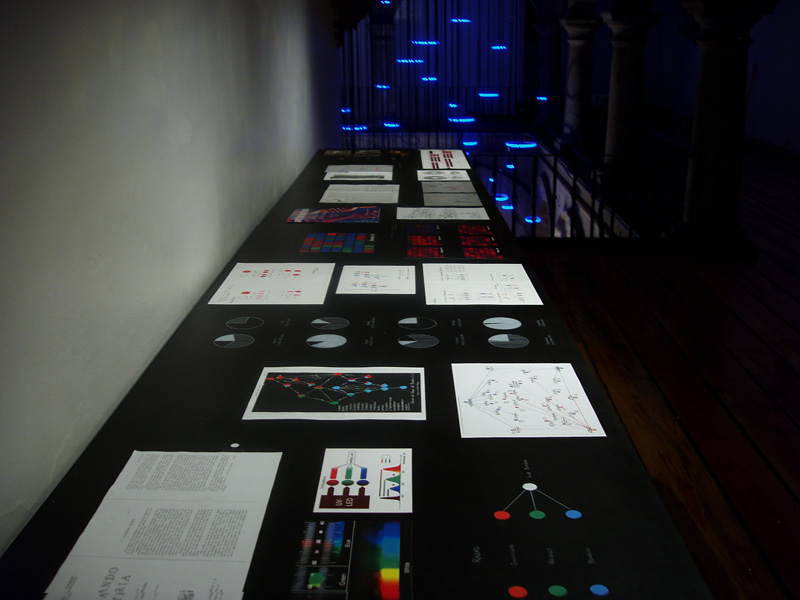
While the representation and miss-representation of non-white subjects in popular media has been central to the maintenance of power, it is also true that the analysis (and production) of images must go beyond issues of misrepresentation. As Bhabha — following in Frantz Fanon’s footsteps — has argued, the point is to expose the hidden process whereby colonial discourse produced fetishes and stereotypes to conceal the construction of representations that justify a set of discriminatory practices, rendering them natural and recognized as “a common knowledge in a range of cultural, political and historical discourses”15. I argue that Meyenberg’s Return to the Present and Étude taxonomique exposes the ideological formation of this “common knowledge,” and addresses color as the most visible, yet questionable mark of racialized identity in contemporary Mexico.
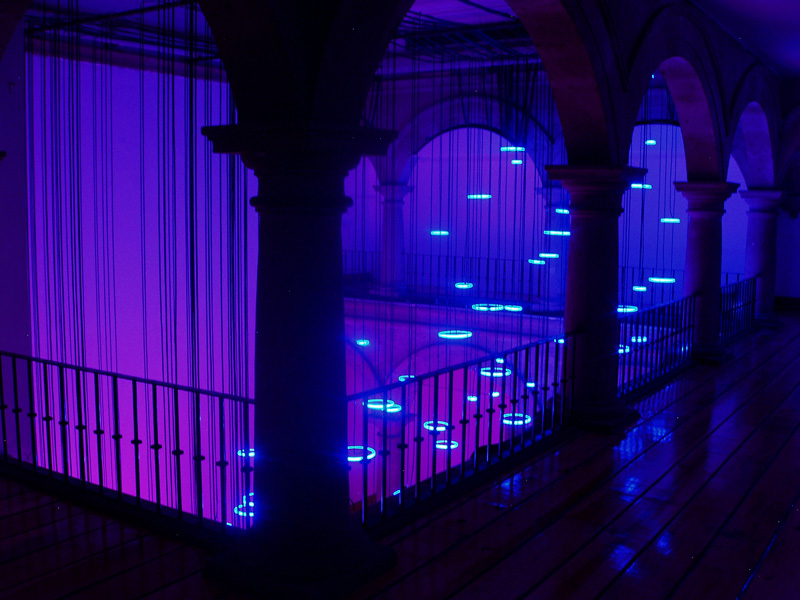
The Question of Technology and Race
Finally, it is necessary to draw attention to the relationship between Meyenberg’s deployment of electronic technologies and the question of race, given the continuing discourse of color blindness of the new media industry, scholarship, and the arts. Much of the early literature on new media assumed that physical markers such as race and gender are unimportant in cyberspace and other by-products of electronic technologies. However, as numerous scholars have demonstrated, this is hardly the case in as much as many bodies are still marginalized based through race discourses both, on-line and off-line16. As Lisa Nakamura has explained, the link between U.S. government mainstream discourse of color blindness, and the Clinton administration’s narrative of the information superhighway as a humanitarian mission, perfectly fits the celebratory discourses that championed the Internet in particular, and electronic technologies in general, as democratic technologies allowing social transformations and the redefinition of traditional markers of ethnicity, gender, and race17. On the other hand, while many artists have insisted on the extension of physical limits and bodily functions through the integration with machines, only few artists have actually addressed the relationship between technology and race. Sterlac, a pioneer in the experimentation with robotics and cyborgian figures, stated that once reconfigured in the electronic circuit the human body does not need to function “with the affirmation of its historical and cultural recall but in a zone of erasure”18. According to Sterlac’s perspective, it follows that we are not only beyond representation, but beyond history. His position suggests that the historical and social experiences linked to class, gender, race, and sexuality are no longer relevant in technologically-driven societies19. Contrasting perspectives have been put forward by artists such as Coco Fusco, Rafaél Lozano-Hemmer, Keith Piper, and Erick Meyenberg. In the works previously discussed by Meyenberg, race is problematized as a socio-historical construction, and racial formations literally determine the functioning of the work at the technological and aesthetic levels. Rather than aligning to the color blindness discourse of new media, Meyenberg insists on the permanence of color as a definite marker of contemporary societies. Ironically, by insisting on the historical roots of racism, he exposes both its relevance and obsolesce. Meyenberg’s Return to the Present and Étude taxonomique put science and knowledge produced in the Colonial period in dialogue with science and knowledge produced today, but it is the observer who, ultimately, attends and participates in this dialogue.
Notes
[1] This quote by Homi Bhabha in terms of colonial mimicry. The Location of Culture (London; New York : Routledge, 1994) 122.
[2] In 2010, for instance, Mexico’s National Council to Prevent Discrimination (CONAPRED) conducted the National Survey of Discrimination in Mexico; the results exposed, among other things that access to political decisions is increasingly connected to whiteness, while poverty is linked to both Indigenous status and skin tone. Also striking was the information released about racism among children. See english version of the survey: http://www.conapred.org.mx/userfiles/files/ENADIS-2010-Eng-OverallResults-NoAccss.pdf
[3] Erick Meyenberg in an interview with Laboratorio Arte Alameda. Erick Meyenberg: Revolucion(es). Laboratorio Arte Alameda, 2010. Web. 8 August 2012.
http://www.youtube.com/watch?feature=endscreen&NR=1&v=zsUHN2lCifU
[4] In her groundbreaking Black Looks, bell hooks argues that in order to break with hegemonic modes of representation, a first step is to develop what she calls the Black Looks: Race and Representation (Toronto: Between the Lines Press, 1992) 2.
[5] Michael Omi and Howrad Winant, Racial Formation in the United States: From the 1960s to the 1980s (NY: Routledge, 1986/1989).
[6] Lucius Outlaw, “Toward a Critical Theory of Race,” Anatomy of Racism, ed. David Theo Goldberg (Minneapolis: University of Minnesota Press, 1990) 62.
[7] Ibid. 68
[8] The exhibition RevolucionES was held at Mexico’s Laboratorio Arte Alameda (LAA) from November 2010 to February 2011; the context was Mexico’s celebration of the 200 anniversary of Colonial Independence, and the 100 anniversary of the Revolution. See exhibition brochure
[9] Erick Meyenberg in an interview by Roberta Bosco. “Ecos del pasado en el futuro,” El País (December 12, 2011). Web. 8 August 2012. http://elpais.com/diario/2011/12/12/catalunya/1323655651_850215.html
[10] According to Meyenberg, the number of columns also evokes human 22 pairs of chromosomes plus the two sex chromosomes. Aesthetically and formally, the artists wanted to make an analogy between the information contained in human DNA and its correlation to the social position.
[11] Among the materials on display are drawings of racial mixtures from the artists himself, molecular and genetic diagrams recently published in scientific journals, and the results of the genetic studies of Mexicans released by the Mexican Government in 2009. More recent versions of this installation also included prints, photographs and other representations of Mexican’s indio and mestizo. See ANOMALIA held at the UC San Diego University Art Gallery.
[12] As Gill Casid argues, racial intermixture caused anxieties among the British and French, though they did support the intermixture of plants and the creation “hybrid environments.” See Jill H. Casid, Sowing Empire: Landscape and Colonization (Minneapolis: University of Minnesota Press, 2005) 17 and John S. Haller, Outcasts from Evolution: Scientific Attitudes of Racial Inferiority, 1859-1900 (Urbana, University of Illinois Press, 1971). Also see John P. Jackson, Racism, and Science: Social Impact and Interaction (Santa Barbara, Calif.: ABC-CLIO, 2004).
[13] Edward Long quoted in Jill H. Casid, Op. Cit. 17.
[14] For information about how Mexican children perceive race see video produced by the CONAPRED as part of its campaign Racism in Mexico: Viral Racismo en México.
[15] Homi Bhabha, “The Other Question,” The Location of Culture (London ; New York : Routledge, 1994), 112.
[16] Cameron Bailey, “Virtual Skin,” Immersed in Technology: Art and Virtual Environments, ed. Mary Anne Moser and Douglas MacLeod (Cambridge: MIT Press, 1996); Nakamura, Lisa. Digitizing Race: Visual Cultures of the Internet (Minneapolis, MN: University of Minnesota Press, 2008).
[17] Lisa Nakamura, “Introduction: Digital Racial Formations and Networked Images of the Body,” Op. Cit., 1-35
[18] Stelarc, “The Body is Obsolete,” Art and Electronic Media, ed. Edward Shanken (London; New York: Phaidon, 2009) 253.
[19] Michele White suggests a contrasting view, as she notes that the rejection of the “fleshy body and insistence that corporeality has no effect on the subject is argued from a centered and empowered position where experiences are culturally validated as ‘normal’ and body identity has remained largely unlabeled.” Michele White, The Body and the Screen: Theories of Internet Spectatorship (Cambridge, Mass.: MIT Press, 2006), 182.
